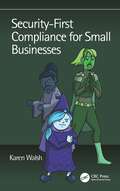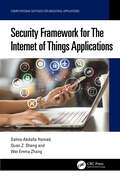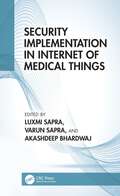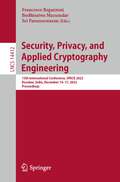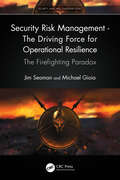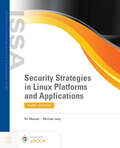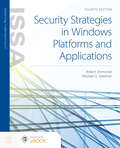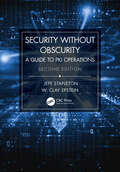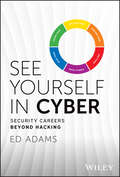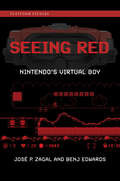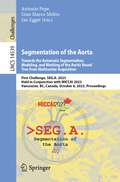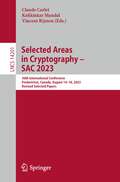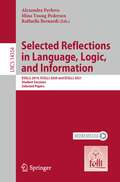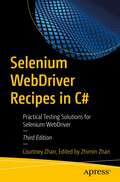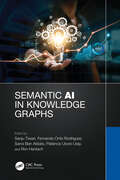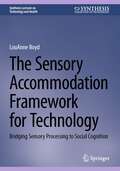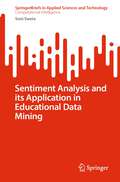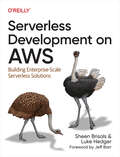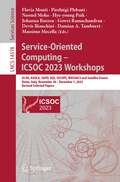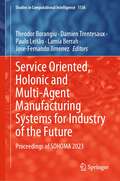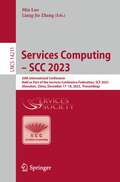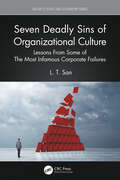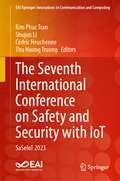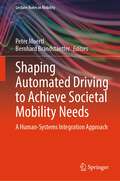- Table View
- List View
Security Breach Files Updated Edition: An AFK Book (Five Nights At Freddy's)
by Scott CawthonCrack open this updated edition of the Security Breach Files for a deep dive into the terrifying game!All that you want to know about the first free-roam Five Nights at Freddy's game is presented here in vivid detail, with thirty-two new pages taking you through the free story "Ruin".This comprehensive breakdown covering gameplay, secrets, Easter eggs, and alternate endings for both the main game and DLC will deepen the knowledge of even the most enthusiastic player. All the evidence, along with every detail of the newest entry into the world of Five Nights at Freddy's is laid out for fans to explore in this one-of-a-kind guide.
Security-First Compliance for Small Businesses
by Karen WalshOrganizations of all sizes struggle to secure their data in a constantly evolving digital landscape. Expanding digital footprints and the rapid expansion of cloud strategies arising from the COVID-19 pandemic increase an organization’s attack surface. When combined with limited resources caused by the cybersecurity skills gap, securing small and mid-sized business IT infrastructures becomes more complicated. With limited staffing and budgetary restrictions, small businesses need to create cost-effective, security-driven programs that protect data while also meeting increasingly stringent compliance requirements. This book bridges the gap between complex technical language and business objectives to create a security-first review of the security and compliance landscapes. Starting from the premise that “with security comes compliance,” this book starts by defining “security-first” and then walking readers through the process of creating a holistic security and compliance program. Looking at security and privacy through the lens of zero trust, this overview of regulations and industry standards provides both background about and implications drawn from modern security practices. Rather than focusing solely on individual cybersecurity frameworks, this book offers insights into best practices based on the commonalities between regulations and industry standards, highlighting some of the primary differences to show the nuances. Woven throughout are practical examples of solutions that enable small and mid-sized businesses to create “cybersustainable” security-focused policies, processes, and controls that protect today’s future for tomorrow’s digital ecosystem.
Security Framework for The Internet of Things Applications (Computational Methods for Industrial Applications)
by Quan Z. Sheng Wei Emma Zhang Salma Abdalla HamadThe text highlights a comprehensive survey that focuses on all security aspects and challenges facing the Internet of Things systems, including outsourcing techniques for partial computations on edge or cloud while presenting case studies to map security challenges. It further covers three security aspects including Internet of Things device identification and authentication, network traffic intrusion detection, and executable malware files detection.This book: Presents a security framework model design named Behavioral Network Traffic Identification and Novelty Anomaly Detection for the IoT Infrastructures Highlights recent advancements in machine learning, deep learning, and networking standards to boost Internet of Things security Builds a near real-time solution for identifying Internet of Things devices connecting to a network using their network traffic traces and providing them with sufficient access privileges Develops a robust framework for detecting IoT anomalous network traffic Covers an anti-malware solution for detecting malware targeting embedded devices It will serve as an ideal text for senior undergraduate and graduate students, and professionals in the fields of electrical engineering, electronics and communication engineering, computer engineering, and information technology.
Security Implementation in Internet of Medical Things
by Luxmi Sapra Varun Sapra Akashdeep BhardwajSecurity implementation is crucial in the Internet of Medical Things (IoMT) as it ensures the protection of sensitive medical data and prevents unauthorized access to or manipulation of devices and systems. This book covers different aspects of security implementations and challenges in IoMT and aims to bring researchers together to contribute their findings to recommend new methodologies and feasible solutions for implementing security and novel architectures in artificial intelligence, machine learning, and data science in the field of healthcare and IoT. IoMT includes a wide range of connected medical devices and systems, such as wearable devices, medical sensors, and electronic health records, that collect, store, and share sensitive medical information. Without proper security measures, this information could be compromised, leading to serious privacy breaches, financial fraud, and even physical harm to patients.
Security, Privacy, and Applied Cryptography Engineering: 13th International Conference, SPACE 2023, Roorkee, India, December 14–17, 2023, Proceedings (Lecture Notes in Computer Science #14412)
by Francesco Regazzoni Bodhisatwa Mazumdar Sri ParameswaranThis book constitutes the refereed proceedings of the 13th International Conference on Security, Privacy, and Applied Cryptography Engineering, SPACE 2023, held in Roorkee, India, in December 2023.The 14 papers included in these proceedings were carefully reviewed and selected from 45 submissions. They focus on various aspects of security, privacy, applied cryptography, and cryptographic engineering.
Security Risk Management - The Driving Force for Operational Resilience: The Firefighting Paradox (Security, Audit and Leadership Series)
by Jim Seaman Michael GioiaThe importance of businesses being ‘operationally resilient’ is becoming increasingly important, and a driving force behind whether an organization can ensure that its valuable business operations can ‘bounce back’ from or manage to evade impactful occurrences is its security risk management capabilities. In this book, we change the perspective on an organization’s operational resilience capabilities so that it shifts from being a reactive (tick box) approach to being proactive. The perspectives of every chapter in this book focus on risk profiles and how your business can reduce these profiles using effective mitigation measures. The book is divided into two sections: 1. Security Risk Management (SRM). All the components of security risk management contribute to your organization’s operational resilience capabilities, to help reduce your risks. • Reduce the probability/ likelihood. 2. Survive to Operate. If your SRM capabilities fail your organization, these are the components that are needed to allow you to quickly ‘bounce back.’ • Reduce the severity/ impact. Rather than looking at this from an operational resilience compliance capabilities aspect, we have written these to be agnostic of any specific operational resilience framework (e.g., CERT RMM, ISO 22316, SP 800- 160 Vol. 2 Rev. 1, etc.), with the idea of looking at operational resilience through a risk management lens instead. This book is not intended to replace these numerous operational resilience standards/ frameworks but, rather, has been designed to complement them by getting you to appreciate their value in helping to identify and mitigate your operational resilience risks. Unlike the cybersecurity or information security domains, operational resilience looks at risks from a business-oriented view, so that anything that might disrupt your essential business operations are risk-assessed and appropriate countermeasures identified and applied. Consequently, this book is not limited to cyberattacks or the loss of sensitive data but, instead, looks at things from a holistic business-based perspective.
Security Strategies in Linux Platforms and Applications
by Ric Messier Michael JangThe third edition of Security Strategies in Linux Platforms and Applications covers every major aspect of security on a Linux system. Using real-world examples and exercises, this useful resource incorporates hands-on activities to walk readers through the fundamentals of security strategies related to the Linux system. Written by an industry expert, this book is divided into three natural parts to illustrate key concepts in the field. It opens with a discussion of the risks, threats, and vulnerabilities associated with Linux as an operating system using current examples and cases. Part 2 discusses how to take advantage of the layers of security available to Linux--user and group options, filesystems, and security options for important services. The book closes with a look at the use of both open source and proprietary tools when building a layered security strategy for Linux operating system environments.
Security Strategies in Windows Platforms and Applications
by Robert Shimonski Michael G. SolomonRevised and updated to keep pace with this ever-changing field, Security Strategies in Windows Platforms and Applications, Fourth Edition focuses on new risks, threats, and vulnerabilities associated with the Microsoft Windows operating system, placing a particular emphasis on Windows 11, and Windows Server 2022. The Fourth Edition highlights how to use tools and techniques to decrease risks arising from vulnerabilities in Microsoft Windows operating systems and applications. The book also includes a resource for readers desiring more information on Microsoft Windows OS hardening, application security, and incident management. With its accessible writing style, and step-by-step examples, this must-have resource will ensure readers are educated on the latest Windows security strategies and techniques.
Security Without Obscurity: A Guide to PKI Operations
by Jeff Stapleton W. Clay EpsteinPublic Key Infrastructure (PKI) is an operational ecosystem that employs key management, cryptography, information technology (IT), information security (cybersecurity), policy and practices, legal matters (law, regulatory, contractual, privacy), and business rules (processes and procedures). A properly managed PKI requires all of these disparate disciplines to function together – coherently, efficiently, effectually, and successfully. Clearly defined roles and responsibilities, separation of duties, documentation, and communications are critical aspects for a successful operation. PKI is not just about certificates, rather it can be the technical foundation for the elusive "crypto-agility," which is the ability to manage cryptographic transitions. The second quantum revolution has begun, quantum computers are coming, and post-quantum cryptography (PQC) transitions will become PKI operation’s business as usual.
See Yourself in Cyber: Security Careers Beyond Hacking
by Ed AdamsA one-of-a-kind discussion of how to integrate cybersecurity into every facet of your organization In See Yourself in Cyber: Security Careers Beyond Hacking, information security strategist and educator Ed Adams delivers a unique and insightful discussion of the many different ways the people in your organization—inhabiting a variety of roles not traditionally associated with cybersecurity—can contribute to improving its cybersecurity backbone. You’ll discover how developers, DevOps professionals, managers, and others can strengthen your cybersecurity. You’ll also find out how improving your firm’s diversity and inclusion can have dramatically positive effects on your team’s talent. Using the familiar analogy of the color wheel, the author explains the modern roles and responsibilities of practitioners who operate within each “slice.” He also includes: Real-world examples and case studies that demonstrate the application of the ideas discussed in the book Many interviews with established industry leaders in a variety of disciplines explaining what non-security professionals can do to improve cybersecurity Actionable strategies and specific methodologies for professionals working in several different fields interested in meeting their cybersecurity obligationsPerfect for managers, directors, executives, and other business leaders, See Yourself in Cyber: Security Careers Beyond Hacking is also an ideal resource for policymakers, regulators, and compliance professionals.
Seeing Red: Nintendo's Virtual Boy (Platform Studies)
by Jose P. Zagal Benj EdwardsThe curious history, technology, and technocultural context of Nintendo&’s short-lived stereoscopic gaming console, the Virtual Boy.With glowing red stereoscopic 3D graphics, the Virtual Boy cast a prophetic hue: Shortly after its release in 1995, Nintendo's balance sheet for the product was "in the red" as well. Of all the innovative long shots the game industry has witnessed over the years, perhaps the most infamous and least understood was the Virtual Boy. Why the Virtual Boy failed, and where it succeeded, are questions that video game experts José Zagal and Benj Edwards explore in Seeing Red, but even more interesting to the authors is what the platform actually was: what it promised, how it worked, and where it fit into the story of gaming.Nintendo released the Virtual Boy as a standalone table-top device in 1995—and quickly discontinued it after lackluster sales and a lukewarm critical reception. In Seeing Red, Zagal and Edwards examine the device's technical capabilities, its games, and the cultural context in the US in the 1990s when Nintendo developed and released the unusual console. The Virtual Boy, in their account, built upon and extended an often-forgotten historical tradition of immersive layered dioramas going back 100 years that was largely unexplored in video games at the time. The authors also show how the platform's library of games conveyed a distinct visual aesthetic style that has not been significantly explored since the Virtual Boy's release, having been superseded by polygonal 3D graphics. The platform's meaning, they contend, lies as much in its design and technical capabilities and affordances as it does in an audience's perception of those capabilities. Offering rare insight into how we think about video game platforms, Seeing Red illustrates where perception and context come, quite literally, into play.
Segmentation of the Aorta. Towards the Automatic Segmentation, Modeling, and Meshing of the Aortic Vessel Tree from Multicenter Acquisition: First Challenge, SEG.A. 2023, Held in Conjunction with MICCAI 2023, Vancouver, BC, Canada, October 8, 2023, Proceedings (Lecture Notes in Computer Science #14539)
by Antonio Pepe Gian Marco Melito Jan EggerThis book constitutes the First Segmentation of the Aorta Challenge, SEG.A. 2023, which was held in conjunction with the 26th International Conference on Medical Image Computing and Computer-Assisted Intervention, MICCAI 2023, on October 8, 2023. The 8 full and 3 short papers presented have been carefully reviewed and selected for inclusion in the book. They focus specifically on robustness, visual quality and meshing of automatically generated segmentations of aortic vessel trees from CT imaging. The challenge was organized as a ”container submission” challenge, where participants had to upload their algorithms to Grand Challenge in the form of Docker containers. Three tasks were created for SEG.A. 2023.
Selected Areas in Cryptography – SAC 2023: 30th International Conference, Fredericton, Canada, August 14–18, 2023, Revised Selected Papers (Lecture Notes in Computer Science #14201)
by Claude Carlet Kalikinkar Mandal Vincent RijmenThis book contains revised selected papers from the 30th International Conference on Selected Areas in Cryptography, SAC 2023, held in Fredericton, New Brunswick, Canada, in August 2023.The 21full papers presented in these proceedings were carefully reviewed and selected from 45 submissions. The papers are organized in the following topical sections: Cryptanalysis of Lightweight Ciphers; Side-Channel Attacks and Countermeasures; Post-Quantum Constructions; Symmetric cryptography and fault attacks; Post-Quantum Analysis and Implementations; Homomorphic encryption; Public-Key Cryptography; and Differential Cryptanalysis.
Selected Reflections in Language, Logic, and Information: ESSLLI 2019, ESSLLI 2020 and ESSLLI 2021 Student Sessions, Selected Papers (Lecture Notes in Computer Science #14354)
by Alexandra Pavlova Mina Young Pedersen Raffaella BernardiThe European Summer School in Logic, Language and Information (ESSLLI) is organized every year by the Association for Logic, Language and Information (FoLLI) in different sites around Europe. The papers cover vastly dierent topics, but each fall in the intersection of the three primary topics of ESSLLI: Logic, Language and Computation. The 13 papers presented in this volume have been selected among 81 submitted papers over the years 2019, 2020 and 2021. The ESSLLI Student Session is an excellent venue for students to present their work and receive valuable feedback from renowned experts in their respective fields. The Student Session accepts submissions for three different tracks: Language and Computation (LaCo), Logic and Computation (LoCo), and Logic and Language (LoLa).
Selenium WebDriver Recipes in C#: Practical Testing Solutions for Selenium WebDriver
by Courtney ZhanSolve your Selenium WebDriver problems with this quick guide to automated testing of web applications with Selenium WebDriver in C#. This third edition contains hundreds of solutions to real-world problems, with clear explanations and ready-to-run Selenium test scripts that you can use in your own projects. Updated to Selenium version 4, this revision includes Visual Studio Code set up, additional recipes, and new chapters on Selenium DevTools and continuous testing. You'll see how to use Selenium WebDriver for select lists, navigation, assertions, frames, file upload and pop-up dialogs. You'll also learn how to locate web elements and test functions for hyperlinks, buttons, TextFields and TextAreas, radio buttons, CheckBoxes, and more. What You'll Learn Debug test scripts and test data Work with Selenium Remote Control Server Manage and deal with browser profiles and capabilities Monitor tests for advanced user interactions and experiences (UX) Who This Book Is For Experienced .NET and C# Windows application programmers/developers.
Semantic AI in Knowledge Graphs
by Sanju Tiwari Fernando Ortíz-Rodriguez Sarra Ben Abbés Patience Usoro Usip Rim HantachRecent combinations of semantic technology and artificial intelligence (AI) present new techniques to build intelligent systems that identify more precise results. Semantic AI in Knowledge Graphs locates itself at the forefront of this novel development, uncovering the role of machine learning to extend the knowledge graphs by graph mapping or corpus-based ontology learning. Securing efficient results via the combination of symbolic AI and statistical AI such as entity extraction based on machine learning, text mining methods, semantic knowledge graphs, and related reasoning power, this book is the first of its kind to explore semantic AI and knowledge graphs. A range of topics are covered, from neuro-symbolic AI, explainable AI and deep learning to knowledge discovery and mining, and knowledge representation and reasoning. A trailblazing exploration of semantic AI in knowledge graphs, this book is a significant contribution to both researchers in the field of AI and data mining as well as beginner academicians.
The Sensory Accommodation Framework for Technology: Bridging Sensory Processing to Social Cognition (Synthesis Lectures on Technology and Health)
by LouAnne BoydThis book provides a thorough introduction to the many facets of designing technologies for autism, with a particular focus on optimizing visual attention frameworks. This book is designed to provide a detailed overview of several aspects of technology for autism. Each Chapter illustrates different parts of the Sensory Accommodation Framework and provides examples of relevant available technologies. The books first discusses a variety of skills that make up human development as well as a history of autism as a diagnosis and the birth of the neurodiversity movement. It goes on to detail individual types of therapy and how they interact with autism. The systems involved in sensory processing and their specific relation to autism are then explored, including through technologies that have addressed these areas and applications for designers. Readers will learn about designing sensory environments and sensory interactions, such as through virtual reality. This book places a needed emphasis on the hierarchy of information in technology development by exploring visual attention in neurodivergent conditions like autism, ADHD, and dyslexia. It also delves into the relationship between sensory perception and nonverbal communication, the bridge between sensory input and social behavior, and dynamic information. The discussion is rounded out with examinations of temporal processing as and multisensory integration as complicating factors that have existing technological solutions. Finally, the book closes with a summary of the sensory accommodation framework in respect to how each layer offers different user experience goals and specific mechanisms to promote those goals. Readers from a variety of research backgrounds will find this book informative and useful, while designers will learn essential skills for effectively designing autism technologies.
Sentiment Analysis and its Application in Educational Data Mining (SpringerBriefs in Applied Sciences and Technology)
by Soni SwetaThe book delves into the fundamental concepts of sentiment analysis, its techniques, and its practical applications in the context of educational data. The book begins by introducing the concept of sentiment analysis and its relevance in educational settings. It provides a thorough overview of the various techniques used for sentiment analysis, including natural language processing, machine learning, and deep learning algorithms. The subsequent chapters explore applications of sentiment analysis in educational data mining across multiple domains. The book illustrates how sentiment analysis can be employed to analyze student feedback and sentiment patterns, enabling educators to gain valuable insights into student engagement, motivation, and satisfaction. It also examines how sentiment analysis can be used to identify and address students' emotional states, such as stress, boredom, or confusion, leading to more personalized and effective interventions. Furthermore, the book explores the integration of sentiment analysis with other educational data mining techniques, such as clustering, classification, and predictive modeling. It showcases real-world case studies and examples that demonstrate how sentiment analysis can be combined with these approaches to improve educational decision-making, curriculum design, and adaptive learning systems.
Serverless Development on AWS
by Sheen Brisals Luke HedgerThe adoption of serverless is on the rise, but until now, little guidance has been available for development teams that want to apply this technology on AWS. This definitive guide is packed with architectural, security, and data best practices and patterns for architects and engineers who want to build reliable enterprise-scale serverless solutions.Sheen Brisals, an AWS Serverless Hero, and Luke Hedger, an AWS Community Builder, outline the serverless adoption requirements for an enterprise, examine the development tools your team needs, and explain in depth the nuances of testing event-driven and distributed serverless services. You'll gain practical guidance for keeping up with change and learn how to build serverless solutions with sustainability in mind.Examine the serverless technology ecosystem and AWS services needed to develop serverless applicationsLearn the approach and preparation required for a successful serverless adoption in an enterpriseLearn serverless architectures and implementation patternsDesign, develop, and test distributed serverless microservices on AWS cloudApply security best practices while building serverless solutionsIdentify and adapt the implementation patterns for your particular use caseIncorporate the necessary measures for observable serverless applicationsImplement sustainable serverless applications in the cloud
Service-Oriented Computing – ICSOC 2023 Workshops: AI-PA, ASOCA, SAPD, SQS, SSCOPE, WESOACS and Satellite Events, Rome, Italy, November 28-December 1, 2023, Revised Selected Papers (Lecture Notes in Computer Science #14518)
by Flavia Monti Pierluigi Plebani Naouel Moha Hye-Young Paik Johanna Barzen Gowri Ramachandran Devis Bianchini Damian A. Tamburri Massimo MecellaThis book constitutes revised selected papers from the scientific satellite events held in conjunction with the 21st International Conference on Service-Oriented Computing, ICSOC 2023. The conference was held in Rome, Italy, during November 28 – December 1, 2023.This year, these satellite events were organized around four main tracks, including a workshop track, a demonstration track, a Ph.D. symposium, and an invited tutorial track.The ICSOC 2023 workshop track consisted of the following six workshops covering a wide range of topics that fall into the general area of service computing:Third International Workshop on AI-Enabled Process Automation (AI-PA 2023)7th Workshop on Adaptive Service-Oriented and Cloud Applications (ASOCA2023)First International Workshop on Secure, Accountable and Privacy-Preserving Data-Driven Service-Oriented Computing (SAPD 2023)First Services and Quantum Software Workshop (SQS 2023)First International Workshop on Sustainable Service-Oriented Computing: Addressing Environmental, Social, and Economic Dimensions (SSCOPE 2023) 19th International Workshop on Engineering Service-Oriented Applications and Cloud Services (WESOACS 2023)
Service Oriented, Holonic and Multi-Agent Manufacturing Systems for Industry of the Future: Proceedings of SOHOMA 2023 (Studies in Computational Intelligence #1136)
by Theodor Borangiu Damien Trentesaux Paulo Leitão Lamia Berrah Jose-Fernando JimenezThe scientific theme of the book is “Sustainability for the digital manufacturing era” which is focused on how the technological enablers of digital systems drive the sustainability for products, processes, manufacturing, and logistics systems in the industry of the future. The book’s chapters describe sustainability drivers specific to the technological advances that motivate, encourage, and engage the economic, social, and environmental aspects within intelligent manufacturing and logistics systems. The novelty of this approach consists in extending the economic sustainability of digital manufacturing with the ethical perspective at human social scale. The general scope of the book is to foster innovation in smart and sustainable manufacturing and logistics systems and in this context to promote concepts, methods, and solutions for the digital transformation of manufacturing through service orientation in holonic and agent-based control with distributed intelligence. The book’s readership is comprised of researchers and engineers working in the value chain of products and processes, who develop digital control solutions in the “Industry of the Future” vision. The book is also addressed to master’s and Ph.D. students enrolled in Engineering Sciences programs.
Services Computing – SCC 2023: 20th International Conference, Held as Part of the Services Conference Federation, SCF 2023, Shenzhen, China, December 17–18, 2023, Proceedings (Lecture Notes in Computer Science #14211)
by Min Luo Liang-Jie ZhangThis book constitutes the refereed proceedings of the 20th International Conference on Services Computing, SCC 2023, held in Shenzhen, China, during December 17–18, 2023.The 6 full papers in this book were carefully reviewed and selected from 18 submissions. They are organized in topical sections as follows: business modeling, business consulting, solution creation, service delivery, and software architecture design, development, and deployment.
Seven Deadly Sins of Organizational Culture: Lessons From Some of The Most Infamous Corporate Failures (Security, Audit and Leadership Series)
by L. T. SanThis book is about the primary symptoms present in a dysfunctional culture that could have devastating outcomes for any organization. The book outlines each of the seven sins in each chapter. Each of the first seven chapters (Chapters 1–7) starts with a famous quote related to each of the sins and then immediately recounts stories ripped from the headlines describing well-known corporate failures but with a personal touch from former employees who experienced those stories from inside the company. (The sources for these stories are all cited in their Bibliographies.) The seven sins of organizational culture are linked with seven different corporate scandals that serve as a "lesson learned" as well as seven stories of organizations that have been successful with each respective organizational attribute as follows: Flawed Mission and Misaligned Values uses WorldCom as the lesson learned and Patagonia as the success case. Flawed Incentives uses Wells Fargo as the lesson learned and Bridgeport Financial as the success case. Lack of Accountability uses HSBC as the lesson learned and McDonald’s as the success case. Ineffective Talent Management uses Enron as the lesson learned and Southwest Airlines as the success case. Lack of Transparency uses Theranos as the lesson learned and Zappos as the success case. Ineffective Risk Management uses the 2008 mortgage industry collapse as the lesson learned and Michael Burry as the success case. Ineffective Leadership summarizes all of the foregoing sins as failures of Leadership. In each chapter and for each organizational sin, the author offers seven attributes of a healthy culture to counter the cultural dysfunction. The seven healthy attributes for each of the seven sins are all original content. In Chapter 8, the author offers an approach for assessing an organization’s culture by providing seven ways to measure the different drivers of organizational culture. The ideas for how to measure corporate culture is original content, with some references to existing frameworks (all cited in the Bibliography.) Finally, in Chapter 9, the author offers a step-by-step outline for transforming the culture. The chapter starts with a story about how Korean Air suffered multiple crashes due to their corporate culture but were able to successfully transform their culture. (The source for the Korean Air story is cited in the Bibliography.) There are seven appendices, most of which are by the author except for the maturity of risk management, which references an OECD (government entity) risk management maturity framework.
The Seventh International Conference on Safety and Security with IoT: SaSeIoT 2023 (EAI/Springer Innovations in Communication and Computing)
by Kim Phuc Tran Shujun Li Cédric Heuchenne Thu Huong TruongThis book presents the Fifth International Conference on Safety and Security with IoT (SaSeIoT 2023), which took place Bratislava, Slovakia, October 24-26, 2023. The conference aims to explore not only IoT and its related critical applications but also IoT towards Security and Safety. The conference solicits original and inspiring research contributions from experts, researchers, designers, and practitioners in academia, industry and related fields and provides a common platform to share knowledge, experience and best practices in various domains of IoT.
Shaping Automated Driving to Achieve Societal Mobility Needs: A Human-Systems Integration Approach (Lecture Notes in Mobility)
by Peter Moertl Bernhard BrandstaetterThis edited book describes novel human-systems integration approaches to improve acceptance, safety, and comfort of automated vehicles. Each chapter analyses different aspects in the development of automated driving systems such as: assessing needs and opportunities of specific user populations i.e. elderly drivers and truck drivers; creating fluid human-systems interactions in the vehicle to answer specific driver needs; developing an automated driving tutoring application; and identifying benefits of including road infrastructure sensors to support automated driving predictability. A detailed description of the assessment of the above-described solutions in real-world situations is also included. Written by both researchers and professionals, this book offers timely and practice-oriented information concerning the development of automated driving systems that better adapt to the users’ needs.

